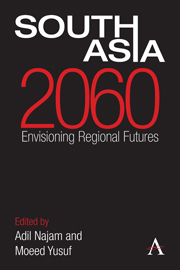Book contents
- Frontmatter
- Contents
- Acknowledgments
- List of Abbreviations
- Introduction: Imagining South Asian Futures
- Section I South Asia as a Region
- Section II State Relations
- Chapter 6 The Future of Democracy
- Chapter 7 Conflict and Reconciliation: Three Scenarios
- Chapter 8 Religion and State Formation
- Chapter 9 Will South Asia Still Be Terrorism's Center of Gravity?
- Chapter 10 Speculations on Nuclear South Asia
- Chapter 11 Nuclear Risk: Overstated or Underrated?
- Chapter 12 The Shadow of the India–Pakistan Stalemate
- Chapter 13 Regional Integration
- Chapter 14 The Future of Integration
- Chapter 15 The Giant Neighbor: Why is China Important?
- Section III Development
- Section IV Human Well-Being
- About the Authors
- Bibliography
- Index
Chapter 14 - The Future of Integration
from Section II - State Relations
Published online by Cambridge University Press: 05 September 2013
- Frontmatter
- Contents
- Acknowledgments
- List of Abbreviations
- Introduction: Imagining South Asian Futures
- Section I South Asia as a Region
- Section II State Relations
- Chapter 6 The Future of Democracy
- Chapter 7 Conflict and Reconciliation: Three Scenarios
- Chapter 8 Religion and State Formation
- Chapter 9 Will South Asia Still Be Terrorism's Center of Gravity?
- Chapter 10 Speculations on Nuclear South Asia
- Chapter 11 Nuclear Risk: Overstated or Underrated?
- Chapter 12 The Shadow of the India–Pakistan Stalemate
- Chapter 13 Regional Integration
- Chapter 14 The Future of Integration
- Chapter 15 The Giant Neighbor: Why is China Important?
- Section III Development
- Section IV Human Well-Being
- About the Authors
- Bibliography
- Index
Summary
Looking ahead towards the South Asia of 2060 would necessitate a close analysis of the historical, religious and ethnic factors that bind the region across contemporary borders; the depth, reach and pace of regional economic integration; the asymmetries in South Asia's human and social development; its security architecture and the impact on South Asia of the extraregional relations it seeks, as well as that of unsolicited interventions.
A report by the United States National Intelligence Council, entitled Global Trends 2025: A Transformed World, released in November 2008, envisaged the contemporary world moving into a period of historic changes, including what it described as a transfer of “global wealth and economic power […] roughly from West to East” (National Intelligence Council 2008). It anticipated the rise of China and India as powers that could transform the geopolitical scenario. Newsweek magazine moved the assessment's currency well beyond the field of strategic studies, into the wider public domain, reporting what it called “the Post-American world” and the onset of “the Asian Century” (Foroohar 2009). I would prefer to describe it all, with apologies to the music composer Dvorak, as “the New World Symphony.” India, the largest South Asian state, and China, a keen observer in the South Asian Association for Regional Cooperation (SAARC) could function as joint composers or conductors of the symphony, with every nation, including the United States – whose performance should not be downgraded – playing in harmony.
- Type
- Chapter
- Information
- South Asia 2060Envisioning Regional Futures, pp. 108 - 113Publisher: Anthem PressPrint publication year: 2013

